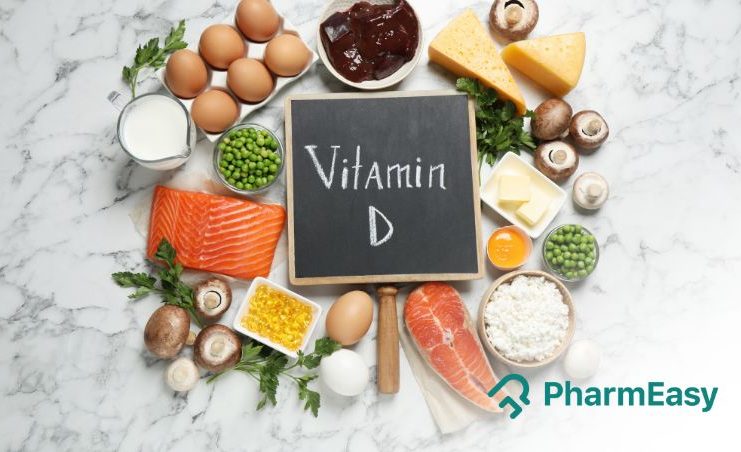Dietary Sources of Vitamin ‘D’
By Saksham Bhatia +2 more

Get insightful and
helpful tips to treat
your symptoms for FREE



Download PharmEasy App




Register to Avail the Offer
Send OTPBy continuing, you agree with our Privacy Policy and Terms and Conditions
By Saksham Bhatia +2 more
You may have got to know about the importance of Vitamin D from your doctor or read about it. While you might think that this is just another health fad, Vitamin D deficiency can cause health-related challenges.

Let’s find out more about Vitamin D, its sources, and why our body needs it.
Table of Contents
Vitamin D is a fat-soluble vitamin, naturally present in some foods and available as a dietary supplement. Another indirect source of vitamin D is sunlight. It is indirect because vitamin D obtained from sun exposure, foods, and supplements is biologically inert. Bioinert materials refer to those substances that, when introduced to the body, don’t cause a reaction with the host. Thus, the body must create vitamin D when exposed to direct sunlight.
When vitamin D enters the body as an inert material, it undergoes two oxidations (chemical) reactions, once in the liver and the other in the kidneys, where it is then converted to active form 1,25-dihydroxy vitamin D [1,25(OH)2D], also known as calcitriol[1,2]
Extensive studies conducted on the role of vitamin D suggest possibilities that go beyond bone health. Some significant health benefits of maintaining vitamin D in a healthy range are listed below [4]:
● Vitamin D aids the body in absorbing and retaining two minerals-phosphorus and calcium, which are vital for bone development.
● Reduced risk of rickets in children and osteomalacia (a condition that leads to weak bone) in adults.
● Vitamin D, along with calcium, can reduce the risk of osteoporosis.
● Vitamin D also supports immunity, helping the body fight several infections and lower the risk of autoimmune conditions.
● Helps reduce negative emotions and, therefore, may be helpful for people with depression.
● Vitamin D is important for muscles, nerves and the functioning of other hormones and enzymes in the body.
Aside from sunlight, the other two sources of vitamin D are food and supplements. With respect to food, there are two categories; there are some foods that naturally contain vitamin D, and others need to be fortified with it. Food sources of vitamin D, along with their serving (micrograms per serving), are provided below[5]:
| FOOD SOURCES | MCG PER SERVING (Approximate) |
| Cod liver oil, 1 tablespoon | 34 |
| Sardines, 2 sardines canned in oil | 1.2 |
| Salmon, 85.05 grams | 14.2 |
| Egg, 1 scrambled | 1.1 |
| Cheese, 42.52 grams | 0.4 |
| Broccoli, ½ cup raw | 0 |
| Mushrooms, exposed to UV light, ½ cup | 9.2 |
| Fortified milk, 1 cup | 2.9 |
| Fortified cereals and oatmeal | 2.0 |
| Fortified soy, almond, oat milk, 1 cup | 2.5-3.6 |
It is believed that India, despite being a tropical country, has approximately 490 million people who are vitamin D deficient [6]. Of this number, around 31% are children and adolescents people [6]. Although it is important to have Vitamin D sufficient to lower chances of developing broken bones and osteoporosis, it will also be prudent to measure the amount and intensity of sunlight exposure that one subjects themselves to during the day as too much of it can also lead to other serious conditions such as skin cancer.
Obtaining vitamin D from food and supplements is the best solution with limited early morning sun exposure when the intensity of the sunlight is softer for about 30 minutes daily. Consult your doctor to understand better and make an informed decision.
Disclaimer: The information included on this site is for educational purposes only and is not intended to be a substitute for medical treatment by a healthcare professional. Because of unique individual needs, the reader should consult their physician to determine the appropriateness of the information for the reader’s situation.
Sources:

Leave your comment...
Comments